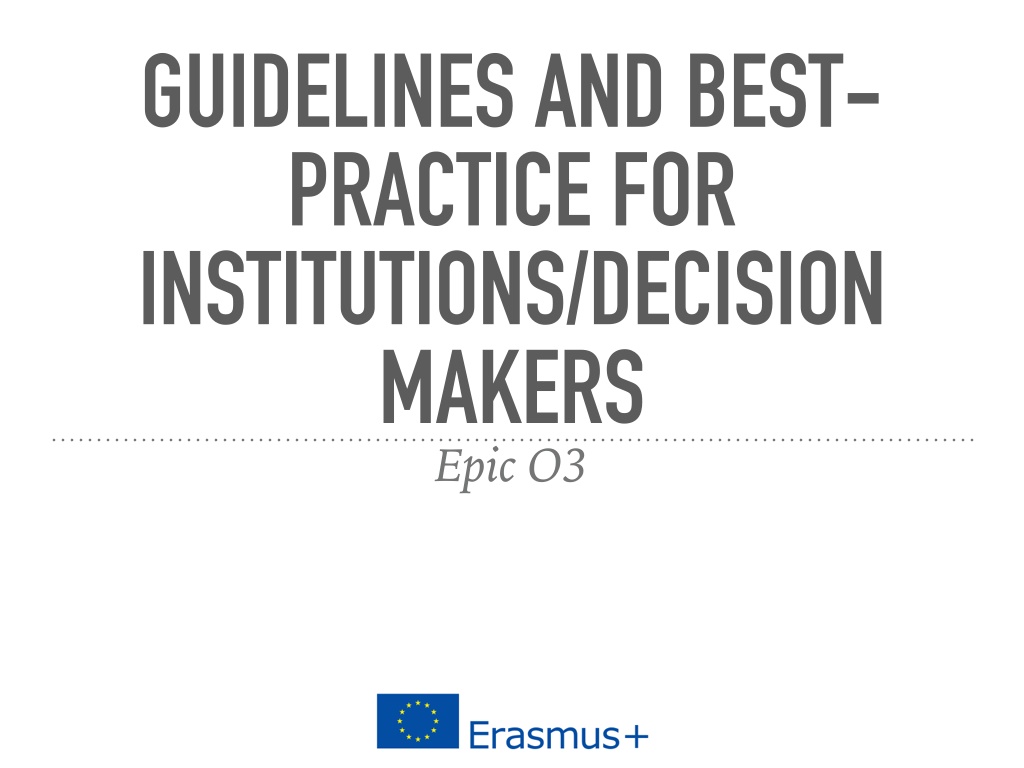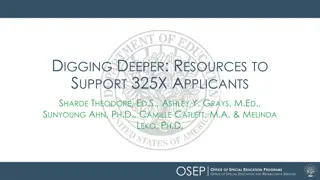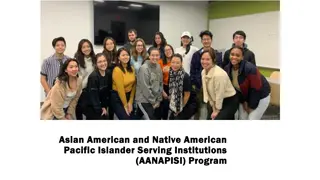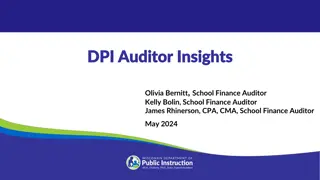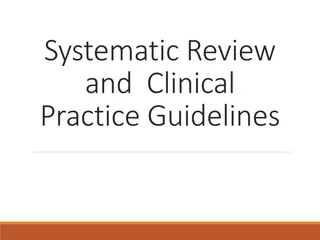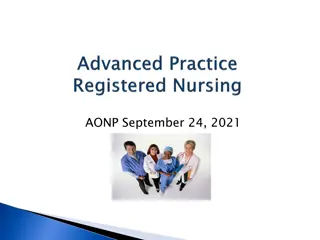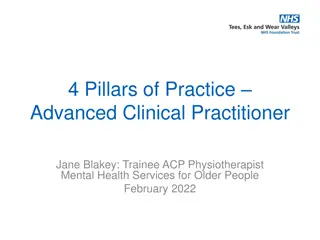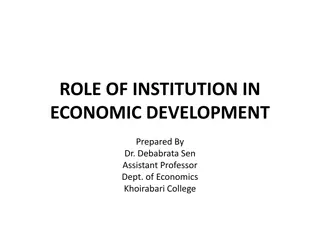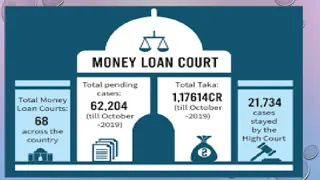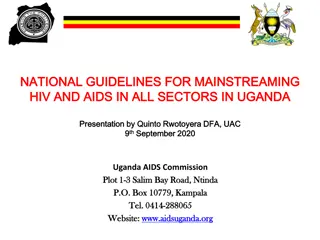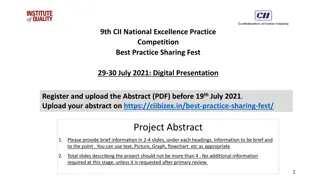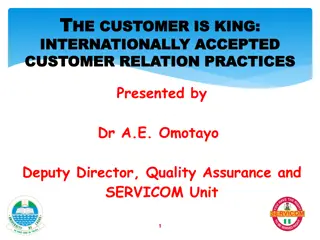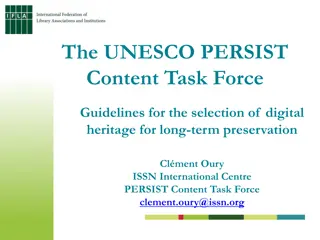Guidelines and Best Practice for Institutions
Epic O3 aims to provide guidance on fostering closer collaboration between academia and universities, focusing on student projects, problem-based learning, international collaboration, innovation, and entrepreneurship. The diverse backgrounds of participants offer both challenges and advantages in creating a responsive learning community. The expected impact includes encouraging innovative teaching methods and sharing guidelines within institutional networks like ECIU and CDIO.
Download Presentation

Please find below an Image/Link to download the presentation.
The content on the website is provided AS IS for your information and personal use only. It may not be sold, licensed, or shared on other websites without obtaining consent from the author.If you encounter any issues during the download, it is possible that the publisher has removed the file from their server.
You are allowed to download the files provided on this website for personal or commercial use, subject to the condition that they are used lawfully. All files are the property of their respective owners.
The content on the website is provided AS IS for your information and personal use only. It may not be sold, licensed, or shared on other websites without obtaining consent from the author.
E N D
Presentation Transcript
GUIDELINES AND BEST- PRACTICE FOR INSTITUTIONS/DECISION MAKERS Epic O3
OUTPUT DESCRIPTION (INCLUDING: ELEMENTS OF INNOVATION, EXPECTED IMPACT AND TRANSFERABILITY POTENTIAL) 1 EPIC aims to gather the experiences from the multiple learning methods and infrastructure tested out in courses with students and lecturers from several universities with a focus towards institutions and decision makers. In the O3 output, we aim to provide guidance on an institutional level in how closer collaboration between academia and universities in terms of (1) student projects, (2) problem based learning, (3) international collaboration and (4) innovation and entrepreneurship can be supported. The background of the participants in EPIC is diversified which provides both challenges and advantages regarding the learning community: It is a challenge since we can not assume a common background of the students coming from different parts of Europe. And it is even more diversified as many students originate from other countries and cultures, and to an extend that we even accept students from a wide range of engineering and business studies. In this sense, we are ahead of the multicultural background that most European universities move into due to exchange programs, immigration, etc. It is an advantage as most innovation research indicates that mixed diversified backgrounds promote innovation provided that one can create a responsive learning community. And to establish and promote a responsive learning community is exactly our goal. We relate strongly to the problem-based learning experiences tested out through many years in Aalborg, but most of the other partner universities also have long experiences in collaborating with industry and introducing this reality to students. Some parts are related to organizational learning processes versus individual learning processes, and to increased motivation in learning due to real-world problems with a company as a customer.
OUTPUT DESCRIPTION (INCLUDING: ELEMENTS OF INNOVATION, EXPECTED IMPACT AND TRANSFERABILITY POTENTIAL) 2 For the O3 output we will come up with recommendations as to how the learning processes can be supported at an institutional level. The gathered experiences will be transferred into guidelines and best practice reports, which will be distributed within and beyond the participating organizations. Impact, exploitation and further use: We expect an impact on the participating universities and beyond, where the guidelines can encourage and support the take-up of new and innovative teaching methods based on the methods developed in EPIC. The guidelines will be made publicly available. Since the target group is institutions and decision makers, we believe the main way to spread the knowledge about them will be within our own organizations as well as through relevant institutional networks such as ECIU (European Consortium of Innovative Universities) and the CDIO (Conceive-Design- Implement-Operate) initiative.
OUTPUT DESCRIPTION (INCLUDING: ELEMENTS OF INNOVATION, EXPECTED IMPACT AND TRANSFERABILITY POTENTIAL) 3 O3 will be organized as an activity with members from three universities (UiS, AAU and AGU) and UTP for quality assurance. The tasks are to collect data/cases from the courses, to develop guidelines according to the collected experiences, and write the guidelines with best practice cases into reports. UiS is the main responsible for creation of the module, is time-keeper, and participates in discussions about examples and recommendations. AGU contributes by collecting and describing examples to be used in the guidelines, exemplifying how institutions can contribute to and support the take-up of the teaching methods used in EPIC, but also identifies barriers and potential problems. AAU drafts the specific recommendations/guidelines based on the cases collected and examples discussed by AGU , which are discussed and finalized together with AGU and UiS. The work is intended to take place each year at the end of the yearly cycle (July - September). In the first two years an initial version will be ready by September 15, then reviewed by October 1, revised by October 15 and released no later than November 1.This is done in order to take into accounts comments received during the management meeting in September. In the last year the schedule is pushed forward so the output is finished before the end of August. The materials are revised, extended and improved each year according to the experiences from the previous cycle.
O3 DECISION MAKER GUIDELINES: (0) INSTITUTIONAL In order to establish and coordinate projects (like Master thesis work etc) between several universities and companies in different countries we need to address: How to achieve similar time period for collaboration with differences in expected period at participating universities How to coordinate evaluation criteria in terms of ECTS, defence or no defence at delivery, and expectations to content. Local and / or common tutor in a project with several universities Cost and time when students travel to or are staying with involved company in addition to possible Erasmus support Local University might want or need to register student activity
O3 DECISION MAKER GUIDELINES: (1) STUDENT PROJECTS To set up a student project we need to establish a plan for work-schedule including travels, frequency of meeting with tutor and company, and delivery procedure Students need to understand content evaluation criteria both at their local University and how these might deviate for the other students in their group. Student needs to understand from the start expectations of involved companies both in terms of involvement in the process and expectations to the outcome
O3 DECISION MAKER GUIDELINES: (2) PROBLEM BASED LEARNING Problem Based Learning implies that the learning initiatives from a real world issue and that the learning process evolve with this as a focus That means that student group need to have necessary background for the problem or be able to achieve this in the process Basically PBL is a process with the group understanding 1 Who is the customer 2 What can we do for the customer or collaborate 3 What kind of process is involved in the problem 4 What kind of requirements and benefits might occur 5 How do we design, build , or present the product / report 6 How can can the company use or scale up the result
O3 DECISION MAKER GUIDELINES: (3) INTERNATIONAL COLLABORATION To collaborate across borders need coordination between faculty, university administration, and companies When groups are starting they need to know what to expect regarding which tutors, their expected meeting frequency, and what content evaluation criteria at their institutions Institutions need to select participating students in a fair open and transparent manner. These should ideally fit schedule in availability and cost coverage in addition to fitting background and level of marks. Universities must be able to provide access for international visiting students for learning systems, communication etc
O3 DECISION MAKER GUIDELINES: (4) INNOVATION AND ENTREPRENEURSHIP Innovation is commonly seen as invention*commercialization, and is typical a heading of creative processes in established companies. Entrepreneurship has more focus on establishing a new company based on idea or an innovation process Both needs clear understanding and sometime a contract between students, universities and involved company regarding intellectual property rights, distribution of cost, expectation of time and resources to be used, and possible future income. This might involve legislative regulations from several countries as regulations like IP rights are not standardized. Sometime a non-disclosure agreement might also be important.
